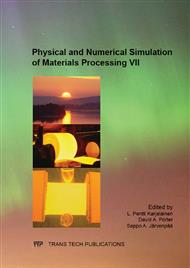p.277
p.283
p.289
p.295
p.301
p.307
p.313
p.319
p.325
Steel Property and Process Models for Quality Control and Optimization
Abstract:
High quality and low variability in the properties of the products are the main goals in manufacturing. The quality of the product is verified by testing different properties. It can be improved with models developed for event prediction. This paper presents with application examples the modelling steps required for effective process modelling. First, the pre-processing and feature extraction phase are illustrated. The modelling phase concentrates especially on the heteroscedasticity problem that is commonly present in industrial applications. The process monitoring and control parameter optimization based on these models is presented, as well as the solution for the lack of observations for the dependent variable. Many of the developed models are in daily use in different process states in steel industry. They enable the design of new products and the analysis of the effects of different process parameters on variability reduction. The proposed methods are application independent.
Info:
Periodical:
Pages:
301-306
Citation:
Online since:
July 2013
Authors:
Price:
Сopyright:
© 2013 Trans Tech Publications Ltd. All Rights Reserved
Share:
Citation:


